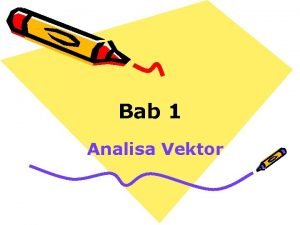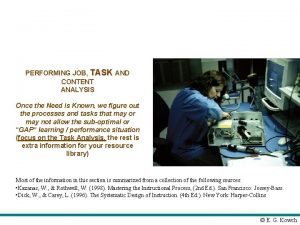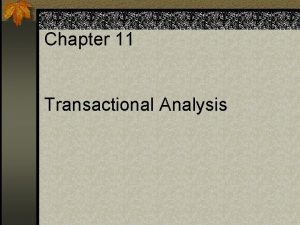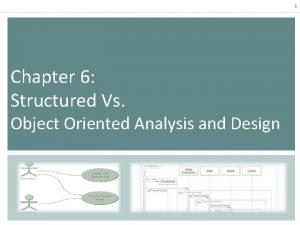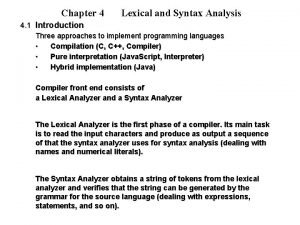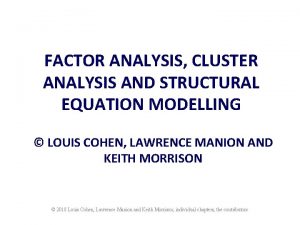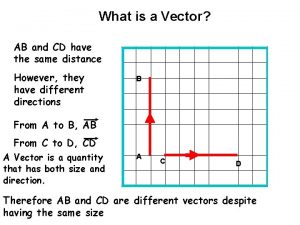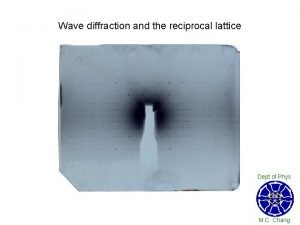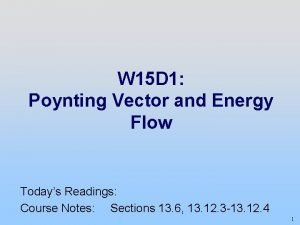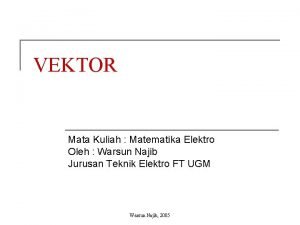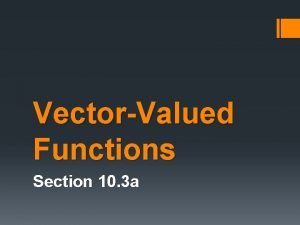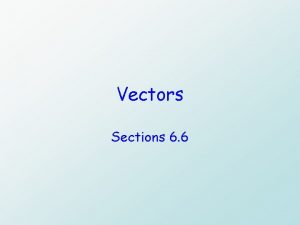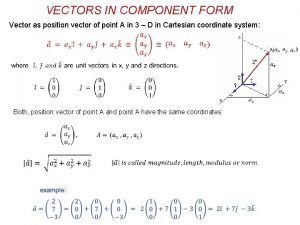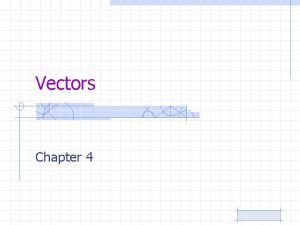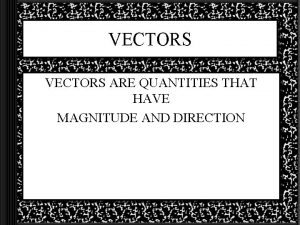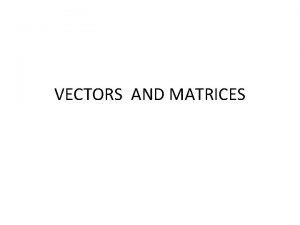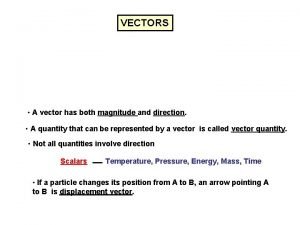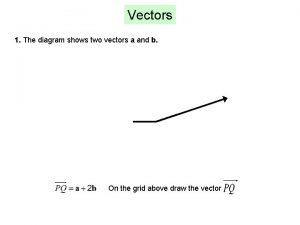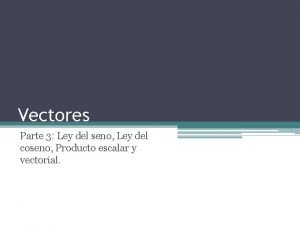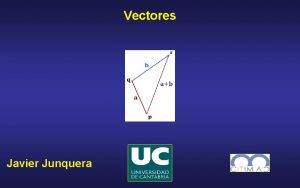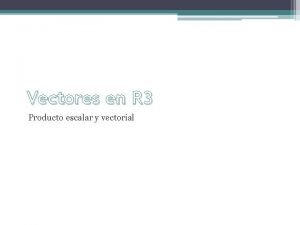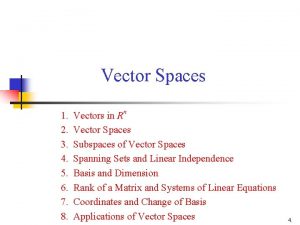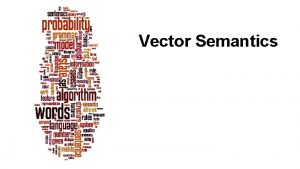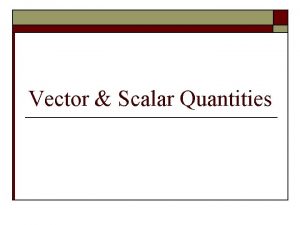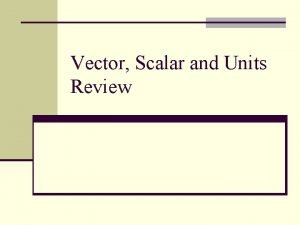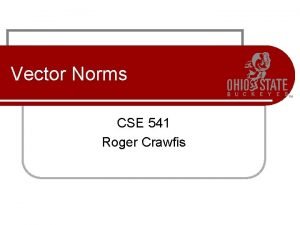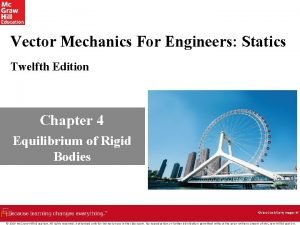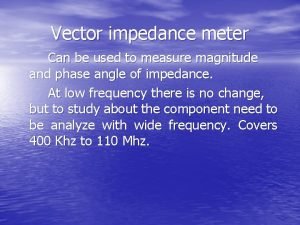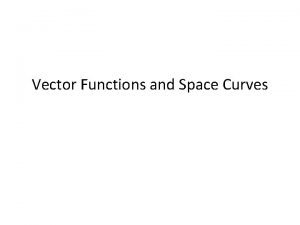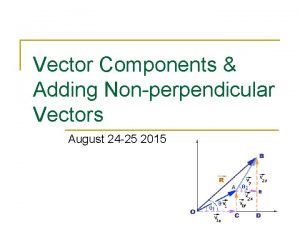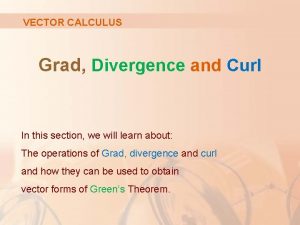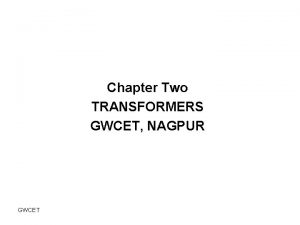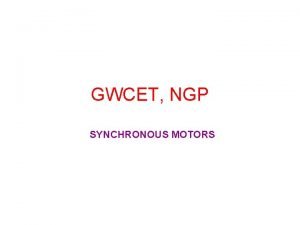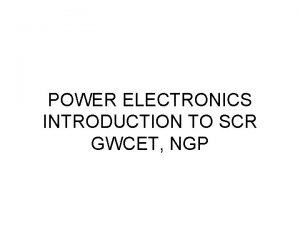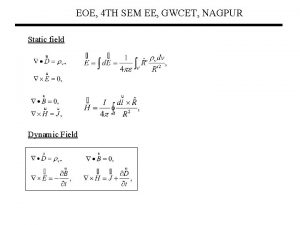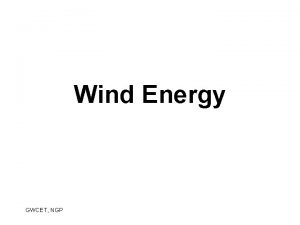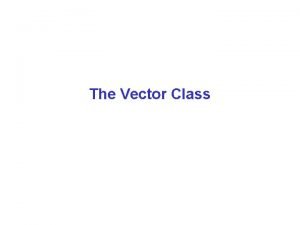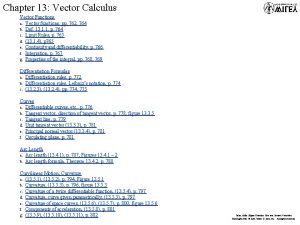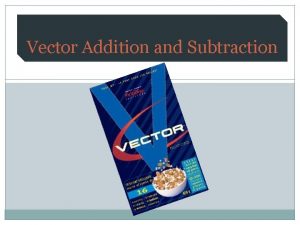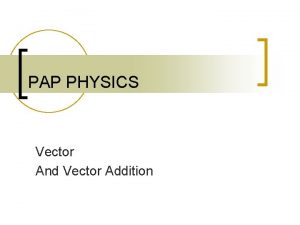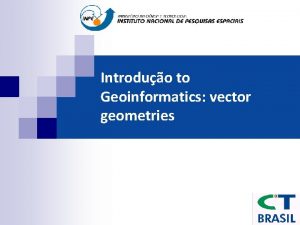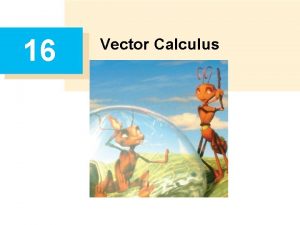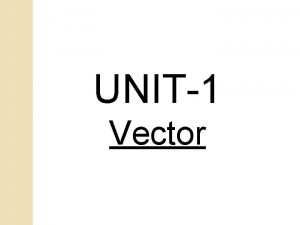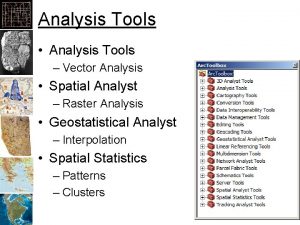Review of Vector Analysis GWCET Review of Vector
























































- Slides: 56

Review of Vector Analysis GWCET

Review of Vector Analysis Vector analysis is a mathematical tool with which electromagnetic (EM) concepts are most conveniently expressed and best comprehended. A quantity is called a scalar if it has only magnitude (e. g. , mass, temperature, electric potential, population). A quantity is called a vector if it has both magnitude and direction (e. g. , velocity, force, electric field intensity). The magnitude of a vector is a scalar written as A or GWCET

Review of Vector Analysis A unit vector along is defined as a vector whose magnitude is unity (that is, 1) and its direction is along Thus which completely specifies direction in terms of A and its GWCET

Review of Vector Analysis A vector in Cartesian (or rectangular) coordinates may be represented as or where AX, Ay, and AZ are called the components of in the x, y, and z directions, respectively; , , and are unit vectors in the x, y and z directions, respectively. GWCET

Review of Vector Analysis Suppose a certain vector is given by The magnitude or absolute value of the vector is (from the Pythagorean theorem) GWCET

Review of Vector Analysis The Radius Vector A point P in Cartesian coordinates may be represented by specifying (x, y, z). The radius vector (or position vector) of point P is defined as the directed distance from the origin O to P; that is, The unit vector in the direction of r is GWCET

Review of Vector Analysis Vector Algebra Two vectors and can be added together to give another vector ; that is , Vectors are added by adding their individual components. Thus, if and GWCET

Review of Vector Analysis Parallelogram rule Head to tail rule Vector subtraction is similarly carried out as GWCET

Review of Vector Analysis The three basic laws of algebra obeyed by any given vector A, B, and C, are summarized as follows: Law Commutative Addition Multiplication Associative Distributive where k and l are scalars GWCET

Review of Vector Analysis When two vectors and are multiplied, the result is either a scalar or a vector depending on how they are multiplied. There are two types of vector multiplication: 1. Scalar (or dot) product: 2. Vector (or cross) product: The dot product of the two vectors and is defined geometrically as the product of the magnitude of and the projection of onto (or vice versa): where is the smaller angle between and GWCET

Review of Vector Analysis If and which is obtained by multiplying component then and component by GWCET

Review of Vector Analysis The cross product of two vectors and is defined as where is a unit vector normal to the plane containing and. The direction of is determined using the righthand rule or the right-handed screw rule. Direction of and using (a) right-hand rule, (b) right-handed screw rule GWCET

Review of Vector Analysis If and then GWCET

Review of Vector Analysis Note that the cross product has the following basic properties: (i) It is not commutative: It is anticommutative: (ii) It is not associative: (iii) It is distributive: (iv) GWCET

Review of Vector Analysis Also note that which are obtained in cyclic permutation and illustrated below. Cross product using cyclic permutation: (a) moving clockwise leads to positive results; (b) moving counterclockwise leads to negative results GWCET

Review of Vector Analysis Scalar and Vector Fields A field can be defined as a function that specifies a particular quantity everywhere in a region (e. g. , temperature distribution in a building), or as a spatial distribution of a quantity, which may or may not be a function of time. Scalar quantity Vector quantity scalar function of position vector function of position scalar field vector field GWCET

Review of Vector Analysis GWCET

Review of Vector Analysis Line Integrals A line integral of a vector field can be calculated whenever a path has been specified through the field. The line integral of the field along the path P is defined as GWCET

Review of Vector Analysis GWCET

Review of Vector Analysis Example. The vector is given by is a constant. Find the line integral where Vo where the path P is the closed path below. It is convenient to break the path P up into the four parts P 1, P 2, P 3 , and P 4. GWCET

Review of Vector Analysis For segment P 1, Thus For segment P 2, and GWCET

Review of Vector Analysis For segment P 3, GWCET

Review of Vector Analysis Example. Let the vector field be given by. Find the line integral of over the semicircular path shown below Consider the contribution of the path segment located at the angle GWCET

Review of Vector Analysis GWCET

Review of Vector Analysis Surface Integrals Surface integration amounts to adding up normal components of a vector field over a given surface S. The flux of a vector field A through surface S We break the surface S into small surface elements and assign to each element a vector is equal to the area of the surface element is the unit vector normal (perpendicular) to the surface element GWCET

Review of Vector Analysis (If S is a closed surface, is by convention directed outward) Then we take the dot product of the vector field at the position of the surface element with vector. The result is a differential scalar. The sum of these scalars over all the surface elements is the surface integral. is the component of in the direction of (normal to the surface). Therefore, the surface integral can be viewed as the flow (or flux) of the vector field through the surface S (the net outward flux in the case of a closed surface). GWCET

Review of Vector Analysis Example. Let be the radius vector The surface S is defined by The normal to the surface is directed in the +z direction Find GWCET

Review of Vector Analysis Surface S V is not perpendicular to S, except at one point on the Z axis GWCET

Review of Vector Analysis GWCET

Review of Vector Analysis Introduction to Differential Operators An operator acts on a vector field at a point to produce some function of the vector field. It is like a function of a function. If O is an operator acting on a function f(x) of the single variable X , the result is written O[f(x)]; and means that first f acts on X and then O acts on f. Example. f(x) = x 2 and the operator O is (d/dx+2) O[f(x)]=d/dx(x 2 ) + 2(x 2 ) = 2 x +2(x 2 ) = 2 x(1+x) GWCET

Review of Vector Analysis An operator acting on a vector field either a scalar or a vector. Example. Evaluate can produce (the length operator), at the point x=1, y=2, z=-2 Thus, O is a scalar operator acting on a vector field. Example. x=1, y=2, z=-2 , , Thus, O is a vector operator acting on a vector field. GWCET

Review of Vector Analysis Vector fields are often specified in terms of their rectangular components: where , , and are three scalar features functions of position. Operators can then be specified in terms of , , and. The divergence operator is defined as GWCET

Review of Vector Analysis Example point x=1, y=-1, z=2. . Evaluate at the Clearly the divergence operator is a scalar operator. GWCET

Review of Vector Analysis 1. - gradient, acts on a scalar to produce a vector 2. - divergence, acts on a vector to produce a scalar 3. - curl, acts on a vector to produce a vector 4. -Laplacian, acts on a scalar to produce a scalar Each of these will be defined in detail in the subsequent sections. GWCET

Review of Vector Analysis Coordinate Systems In order to define the position of a point in space, an appropriate coordinate system is needed. A considerable amount of work and time may be saved by choosing a coordinate system that best fits a given problem. A hard problem in one coordinate system may turn out to be easy in another system. We will consider the Cartesian, the circular cylindrical, and the spherical coordinate systems. All three are orthogonal (the coordinates are mutually perpendicular). GWCET

Review of Vector Analysis Cartesian coordinates (x, y, z) The ranges of the coordinate variables are A vector in Cartesian coordinates can be written as The intersection of three orthogonal infinite places (x=const, y= const, and z = const) defines point P. Constant x, y and z surfaces GWCET

Review of Vector Analysis Differential elements in the right handed Cartesian coordinate system GWCET

Review of Vector Analysis GWCET

Review of Vector Analysis Cylindrical Coordinates . - the radial distance from the z – axis - the azimuthal angle, measured from the xaxis in the xy – plane - the same as in the Cartesian system. A vector in cylindrical coordinates can be written as Cylindrical coordinates amount to a combination of rectangular coordinates and polar coordinates. GWCET

Review of Vector Analysis Relationship between (x, y, z) and Positions in the x-y plane are determined by the values of GWCET

Review of Vector Analysis Point P and unit vectors in the cylindrical coordinate system GWCET

Review of Vector Analysis semi-infinite plane with its edge along the z - axis Constant surfaces GWCET

Review of Vector Analysis Metric coefficient Differential elements in cylindrical coordinates GWCET

Review of Vector Analysis Cylindrical surface ( Planar surface ( = const) Planar surface ( z =const) GWCET

Review of Vector Analysis Spherical coordinates . - the distance from the origin to the point P - the angle between the z-axis and the radius vector of P - the same as the azimuthal angle in cylindrical coordinates GWCET

Review of Vector Analysis Point P and unit vectors in spherical coordinates A vector A in spherical coordinates may be written as GWCET

Review of Vector Analysis Relationships between space variables GWCET

Review of Vector Analysis Constant surfaces GWCET

Review of Vector Analysis Differential elements in the spherical coordinate system GWCET

Review of Vector Analysis GWCET

Review of Vector Analysis GWCET

Review of Vector Analysis GWCET

Review of Vector Analysis GWCET

Review of Vector Analysis GWCET

Review of Vector Analysis POINTS TO REMEMBER 1. 2. 3. GWCET

Review of Vector Analysis 4. 5. 6. 7. GWCET
 Unit vector examples
Unit vector examples Suma de dos vectores
Suma de dos vectores How is vector resolution the opposite of vector addition
How is vector resolution the opposite of vector addition Position vector
Position vector Instantaneous value of the emf phasor
Instantaneous value of the emf phasor Notasi skalar
Notasi skalar Chapter review motion part a vocabulary review answer key
Chapter review motion part a vocabulary review answer key Uncontrollable spending ap gov
Uncontrollable spending ap gov Narrative review vs systematic review
Narrative review vs systematic review Traditional and systematic review venn diagram
Traditional and systematic review venn diagram Narrative review vs systematic review
Narrative review vs systematic review Literature review dalam penelitian
Literature review dalam penelitian Sentiment analysis for hotel reviews
Sentiment analysis for hotel reviews Harvard business review swot analysis
Harvard business review swot analysis What are structured analysis tools
What are structured analysis tools Cuckoo sandbox
Cuckoo sandbox Content vs discourse analysis
Content vs discourse analysis Difference between error analysis and contrastive analysis
Difference between error analysis and contrastive analysis Types of intralingual errors
Types of intralingual errors Fact-finding techniques in system analysis and design
Fact-finding techniques in system analysis and design Job content analysis
Job content analysis Transactional analysis criticism
Transactional analysis criticism Structured vs object oriented approach
Structured vs object oriented approach Lexical and syntax analysis
Lexical and syntax analysis Data quality is always a concern with secondary data
Data quality is always a concern with secondary data Candidate system in system analysis and design
Candidate system in system analysis and design Kmo test
Kmo test Vecto ab
Vecto ab Bcc structure factor
Bcc structure factor Poynting vector resistor
Poynting vector resistor Elektro vektor
Elektro vektor Standard unit vector
Standard unit vector Unit vector formula
Unit vector formula Collinear vectors example
Collinear vectors example Vector vs scalar
Vector vs scalar Vectors have magnitude and direction
Vectors have magnitude and direction Vector components
Vector components Dot ans
Dot ans Is a vector has magnitude and direction.
Is a vector has magnitude and direction. Each part of the diagram shows two vectors, a and b.
Each part of the diagram shows two vectors, a and b. Vectores seno y coseno
Vectores seno y coseno Producto escalar de dos vectores
Producto escalar de dos vectores Biderkadura eskalarra
Biderkadura eskalarra Linealmente independiente
Linealmente independiente Vector vacuums
Vector vacuums Vector symbolic architecture
Vector symbolic architecture Basis of v
Basis of v Semantic vector
Semantic vector Scalar characteristics
Scalar characteristics Are newtons scalar or vector
Are newtons scalar or vector Norm van een vector
Norm van een vector Vector mechanics for engineers statics 12th
Vector mechanics for engineers statics 12th Vector impedance meter
Vector impedance meter Find the domain of the vector function
Find the domain of the vector function Components of a vector
Components of a vector Curl of vector in cylindrical coordinates
Curl of vector in cylindrical coordinates Ixj
Ixj





